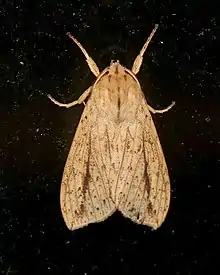Leucanopsis longa
Leucanopsis longa, the long-streaked tussock moth or long-streaked halisidota, is a moth of the family Erebidae. It was described by Augustus Radcliffe Grote in 1880. It is found from North Carolina to Florida and west along the coast to eastern Texas.[2] The habitat consists of marshes and wet sedge meadows.
| Leucanopsis longa | |
|---|---|
 | |
| Scientific classification | |
| Domain: | Eukaryota |
| Kingdom: | Animalia |
| Phylum: | Arthropoda |
| Class: | Insecta |
| Order: | Lepidoptera |
| Superfamily: | Noctuoidea |
| Family: | Erebidae |
| Subfamily: | Arctiinae |
| Genus: | Leucanopsis |
| Species: | L. longa |
| Binomial name | |
| Leucanopsis longa | |
| Synonyms | |
| |
References
- Savela, Markku. "Leucanopsis longa (Grote, 1880)". Lepidoptera and Some Other Life Forms. Retrieved August 8, 2018.
- "930376.00 – 8217 – Leucanopsis longa – Long-streaked Tussock Moth – (Grote, 1880)". North American Moth Photographers Group. Mississippi State University. Retrieved August 8, 2018.
- Pitkin, Brian & Jenkins, Paul. "Search results Family: Arctiidae". Butterflies and Moths of the World. Natural History Museum, London.
This article is issued from Wikipedia. The text is licensed under Creative Commons - Attribution - Sharealike. Additional terms may apply for the media files.